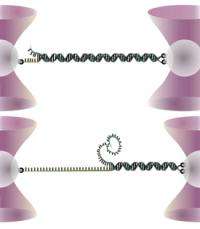New insights into DNA under the influence of strong forces

(������ƵOrg.com) -- Researchers in biophysics, including members from the Niels Bohr Institute, have discovered new properties of DNA and observed a number of phenomena of great importance for cellular mechanisms. By studying how DNA behaves under the influence of a force they have discovered that DNA melts and that the melting bubbles depend on the sequence of the base pairs in the DNA strand. These discoveries are brand new and contrary to what was previously believed, but the discoveries are based on very reliable and precise measurements. The results have just been published in the prestigious scientific journal, Nature ������Ƶics.
DNA is the most important molecule in a living organism. It contains all of the information about the individual and the correct reading of DNA by cellular mechanisms is essential for an organism to remain alive and stay healthy. When DNA is decoded and maintained by the small ‘machines’ of the cell, it is constantly exposed to forces that pull, stretch, squeeze and bend it, making the physical properties of DNA crucial for the correct reading and maintenance.
A research team comprised of researchers from the Niels Bohr Institute at the University of Copenhagen, VU University Amsterdam and ESPCI, Paris has revealed in detail how DNA behaves when subjected to forces like those from the machinery of the cell.
"We found, very surprisingly, that when DNA stretches, it twists in on itself. At low forces it twists in the direction of the DNA’s double helix, but at higher forces it twists backwards, that is to say that the helix shape unfolds”, explains biophysicist at the Niels Bohr Institute, Lene Oddershede, who leads the Optical Tweezer research group.
She explains that, using these physical phenomena, the researchers have built an entirely new theoretical model, which correctly describe the behaviour of DNA when subjected to a force all the way up to the forces that would melt DNA. The new model is called the ‘twistable worm-like-chain’ model.
Melt like bubbles
The researchers have stretched a single DNA molecule using a so-called optical tweezer, which is a nano-tool that is capable of exerting a force on the stretched molecule with incredible precision while measuring precisely how long the molecule is. When DNA is exposed to a force of around 65 pN it will expand considerably without needing to apply more force. What happens is that DNA melts from being double-stranded into being single-stranded. The researchers have shown that when DNA melts it takes place in bubbles, where hundreds of base pairs melt simultaneously. The exact size of the melting bubbles can be predicted by knowing the base pair sequence.
“The results are particularly interesting because they contradict previous literature to a certain degree and reveal new properties of DNA that are very important for cellular mechanisms”, says Lene Oddershede and explains that the reason that this particular research group, with an experimental basis at the Niels Bohr Institute and in Amsterdam, has been able to make these discoveries is that the optical tweezers are of a superior quality and have an incredibly good signal to noise ratio. Such small movements on the curve that originate from ‘melting bubbles’, dismissed by others as noise, were observed by this research group as not being noise, but rather a very meaningful signal which provides information about the basic properties of DNA.
More information: Quantifying how DNA stretches, melts and changes twist under tension, Nature ������Ƶics (2011) DOI:
Abstract
In cells, DNA is constantly twisted, bent and stretched by numerous proteins mediating genome transactions. Understanding these essential biological processes requires in-depth knowledge of how DNA complies to mechanical stress. Two important physical features of DNA, helical structure and sequence, are not incorporated in current descriptions of DNA elasticity. Here we connect well-defined force–extension measurements with a new model for DNA elasticity: the twistable worm-like chain, in which DNA is considered a helical, elastic entity that complies to tension by extending and twisting. In addition, we reveal hitherto unnoticed stick–slip dynamics during DNA overstretching at ~65 pN, caused by the loss of base-pairing interactions. An equilibrium thermodynamic model solely based on DNA sequence and elasticity is presented, which captures the full complexity of this transition. These results offer deep quantitative insight in the physical properties of DNA and present a new standard description of DNA mechanics.
Provided by Niels Bohr Institute

















